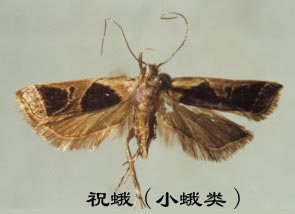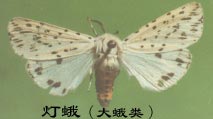[Economic significance] Lepidoptera includes butterflies (butterflies) and moths, and is the second largest order in the class Insecta. Lepidopteran larvae mostly feed on flowering plants, many of which are important pests in agricultural and forestry production and are of great economic importance. Many lepidopteran adults can pollinate flowers. Bombyx moths and other moth insects are famous silk-producing insects. A large number of beautiful and colorful butterflies and moths have great artistic value.
[Identification points] Siphon-type mouthparts, the lower lip must be well developed. The body and wings are densely covered with scales and hairs, and the front and rear wings generally have middle chambers. The larvae are multi-legged, commonly known as caterpillars, and have toe hooks on their abdominal feet.
The characteristics of this order can be summarized as follows: Lepidoptera with siphoning mouthparts, four wings covered with membranous scales; moths dancing between flowers and darting into the fire, larvae with multiple legs and toe hooks.
[Species and Distribution] There are 150,000 known species in the world, of which butterflies account for about 10%, with nearly 20,000 species. About 10,000 species have been recorded in my country, including more than 1,300 species of butterflies.
[Classification system] The classification system of Lepidoptera has gone through many changes, but there is still debate on how many suborders it is divided into. Here, several commonly used systems are introduced as follows:

I. Butterfly and moth
Moth: (1) Antennae are not club-shaped, (2) Nocturnal, (3) Wings are roof-shaped when the body is inactive, (4) Pupa
Butterfly: (1) Antennae are bulbous and rod-shaped, (2) active during the day, (3) wings erect on the back when at rest, (4) hanging pupa (with pupa)

II. Macrolepidoptera and microlepidoptera
Microlepidoptera: (1) The wingspan does not exceed 25mm; (2) There are 2 hip veins on the forewing and 3 hip veins on the hind wing; (3) The hind wing is lanceolate, and the fringe is longer than the width of the wing.
Macrolepidoptera: (1) The wingspan exceeds 25mm; (2) There is one hip vein on the forewing and two hip veins on the hind wing; (3) The hind wing is not lanceolate, and the margins are shorter than the width of the wing.
III. Same venous (yoke-winged) suborder and different venous (rigid-winged) suborders
Homoneura (Jugatae) suborder: Homoneura (Jugatae): There is a yoke on the trailing edge of the forewing, and the veins of the fore and aft wings are reduced.
Heteroneura (Frenatae) suborder: The interlocking device is stiff or wing-embracing type, and the veins of the hind wings are reduced.

IV. Five suborder systems
(1) Zeugloptera: The adult has a well-developed upper jaw and sharp teeth.
(2) Bat moth suborder (Exoporia): The mandibular barbels are tiny or leave only traces, and the front and rear wings have the same veins and the wingspan is more than 20mm.
(3) Dacnynacha: long mandibular palps, 5 segments, same veins for front and rear wings, less than 15m
The mid-foot tibia has 1 spur - Eriocraniidae
The tibia of the midfoot has 2 spurs - Mnesarchaeidae
(4) Monotrysia: The egg-laying hole and the mating hole are combined into one, and the wing membrane has micro spines. Hind wing veins reduced.
No eye patch; forewings have middle chamber. Superfamily Incurvarioidea
Superfamily Nepticuloidea: The ovipositor is normal and has an eye patch; the forewing has no central chamber.
(5) Ditrysia: The egg-laying hole and the mating hole are separated, and the wing membrane has no microthorns. Reduced hind wing veins

Hesxerioidea: The ends of the antennae are hook-shaped, and the meridians of the forewings are separated.
Papilionoidea (Papilionoidea): The ends of the antennae are not hook-shaped, and the forewing veins are merged.

Large moth
Gemetroidea: The hearing organ is located on the abdomen
Noctuoidea: The hearing organ is located on the posterior thorax
Superfamily Sphingoidea: The middle part of the antennae gradually becomes thicker, and the tip is pointed and bent into a hook shape.
Bombycoidea: Wingless and stiff, hind wing shoulder area enlarged
Superfamily Calliduloidea: No hearing organs, stiff wings, and normal antennae
animal tags:
We created this article in conjunction with AI technology, then made sure it was fact-checked and edited by a Animals Top editor.